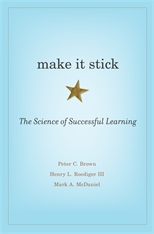ATD Blog
Unlearning What We Think We Know to Inspire Successful Learning
Wed Dec 30 2015

When someone tells us that “\[i\]t turns out that much of what we’ve been doing as teachers and students isn’t serving us well,” we might engage in closed-mindset thinking and blurt out “uh uh.” We might also take the opposite tact and say “talk to me.” And when we’re assured that “some comparatively simple changes could make a big difference,” we are even more likely to adopt a growth mindset and step up to the challenge—as we do by reading Make It Stick: The Science of Successful Learning, by Peter Brown, Henry Roediger, and Mark McDaniel.
This nicely written research-based exploration of what we know, what we thought we knew, and what we ought to know offers plenty of insights into what is going on in the minds of our learners as we work with them to help them meet their learning goals. The warnings up front are strong and eye-opening: “In fact, what students are advised to do is often plain wrong,” the authors tells us in the opening pages of the book before leading us through an examination of learning approaches we’re quickly learning are far from useful.
Drawing on 10 years of research, they offer us a variety of tips that can easily be gleaned from the book’s table of contents: “to learn, retrieve”; “mix up your practice”; “embrace difficulties”; “avoid illusions of knowing”; “get beyond learning styles”; “increase your abilities”; and, ultimately, “make it stick”—all of which sounds somewhat familiar and grounded in common sense, until we join the writers in their explanations and quickly find many of our learning assumptions being effectively challenged by what our learning guides in Make It Stick provide.
They help us understand that tried-and-true learning techniques such as repetitiously practicing something until we have completely learned it is far less effective than we may still assume it is. They also show us that the changes necessary to produce better learning results are far from difficult to implement.
Among the gems sprinkled throughout the book are:
“Today, we know from empirical research that practicing retrieval makes learning stick far better than reexposure to the original material does. This is the testing effect, also known as the retrieval-practice effect.” (p. 28)
“While any kind of retrieval practice generally benefits learning, the implication seems to be that where more cognitive effort is required for retrieval, greater retention results.” (p. 41)
“Practice that’s spaced out, interleaved with other learning, and varied produces better mastery, longer retention and more versatility.” (p. 47)
“It’s the effortful process of reconstructing the knowledge that triggers reconsolidation and deeper learning.” (p. 82-83)
A study completed at UCLA suggests that “our neural circuitry does not mature as early as our physical development and instead continues to change and grow through our forties, fifties, and sixties.” (p. 170)
“\[O\]ur intellectual abilities are not fixed from birth but are, to a considerable degree, ours to shape.” (p. 199)
Even when we find that the research covered in Make It Stick supports approaches we frequently take, we also discover that we may have been engaged in learning activities for the wrong reason. On the topic of quizzes and testing in learning, for example, we find that quizzes used as a low-stakes way of reinforcing learning can be far more fruitful for us and the learners we serve than as a way of validating a learner’s accomplishments. When quizzes are not “onerous events,” the authors note, those quizzes help learners identify gaps in their knowledge so they can plug those gaps. It’s a small, nuanced change in the way we use testing, and the research cited by the authors suggest it can make all the difference in the world in terms of producing learning opportunities with long-term, positive effects.
When the authors lead us through the standard approach of learning by reading and rereading material, they help us understand that the approach produces the illusion of mastery whereas a different approach—based on learners attempting to retrieve material through simple exercises—produces more long-term, significant results. Those acts of retrieval—something as simple as encouraging a learner, at the end of a day, to sit for 10 minutes and write down all that can be recalled—helps learners:
viscerally identify what was not adequately retained
rewire pathways in their brains that solidify the learning we are attempting to foster
find motivation for a more focused approach to plugging learning gaps.
The bottom line here is that the struggle produced by this exercise in recall is one of the actions that makes learning stick.
When we reach the final paragraphs of the book, the news we find is very encouraging and well worth heeding: “…the techniques for highly effective learning that are outlined in this book can be put to use right now everywhere learners, teachers, and trainers are at work. They come at no cost, they require no structural reform, and the benefits they promise are both real and long-lasting.”
About the Book
Brown, P., Roediger, H, & McDaniel, M. (2014). Make It Stick: The Science of Successful Learning. Cambridge and London: The Belknap Press of Harvard University Press.
